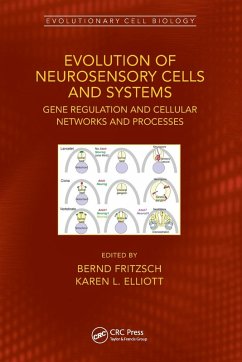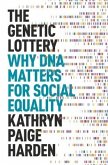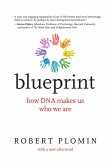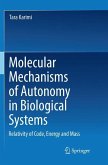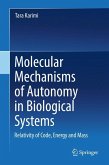Evolution of Neurosensory Cells and Systems
Gene regulation and cellular networks and processes
Herausgeber: Fritzsch, Bernd; Elliott, Karen
Evolution of Neurosensory Cells and Systems
Gene regulation and cellular networks and processes
Herausgeber: Fritzsch, Bernd; Elliott, Karen
- Broschiertes Buch
- Merkliste
- Auf die Merkliste
- Bewerten Bewerten
- Teilen
- Produkt teilen
- Produkterinnerung
- Produkterinnerung
This book is an overview of sensory maps. The eight primary sensory maps of vertebrates have unique features and use distinct molecular cues. As an introduction and overview, the book provides a short overview for all eight sensory senses - olfactory, vision, trigeminal, taste, vestibular, auditory, lateral line, and electroreception.
Andere Kunden interessierten sich auch für
![The Genetic Lottery The Genetic Lottery]() Kathryn Paige HardenThe Genetic Lottery33,99 €
Kathryn Paige HardenThe Genetic Lottery33,99 €![Blueprint Blueprint]() Robert PlominBlueprint12,99 €
Robert PlominBlueprint12,99 €![Molecular Mechanisms of Autonomy in Biological Systems Molecular Mechanisms of Autonomy in Biological Systems]() Tara KarimiMolecular Mechanisms of Autonomy in Biological Systems104,99 €
Tara KarimiMolecular Mechanisms of Autonomy in Biological Systems104,99 €![Endothelial Progenitor Cells Endothelial Progenitor Cells]() Carmela Rita BalistreriEndothelial Progenitor Cells75,99 €
Carmela Rita BalistreriEndothelial Progenitor Cells75,99 €![Hepatic Stem Cells Hepatic Stem Cells]() Hepatic Stem Cells119,99 €
Hepatic Stem Cells119,99 €![Molecular Mechanisms of Autonomy in Biological Systems Molecular Mechanisms of Autonomy in Biological Systems]() Tara KarimiMolecular Mechanisms of Autonomy in Biological Systems104,99 €
Tara KarimiMolecular Mechanisms of Autonomy in Biological Systems104,99 €![Stem Cells for Cancer and Genetic Disease Treatment Stem Cells for Cancer and Genetic Disease Treatment]() Stem Cells for Cancer and Genetic Disease Treatment75,99 €
Stem Cells for Cancer and Genetic Disease Treatment75,99 €-
-
-
This book is an overview of sensory maps. The eight primary sensory maps of vertebrates have unique features and use distinct molecular cues. As an introduction and overview, the book provides a short overview for all eight sensory senses - olfactory, vision, trigeminal, taste, vestibular, auditory, lateral line, and electroreception.
Produktdetails
- Produktdetails
- Verlag: CRC Press
- Seitenzahl: 310
- Erscheinungstermin: 27. Mai 2024
- Englisch
- Abmessung: 234mm x 156mm x 17mm
- Gewicht: 474g
- ISBN-13: 9780367552879
- ISBN-10: 0367552876
- Artikelnr.: 67374075
- Herstellerkennzeichnung
- Libri GmbH
- Europaallee 1
- 36244 Bad Hersfeld
- gpsr@libri.de
- Verlag: CRC Press
- Seitenzahl: 310
- Erscheinungstermin: 27. Mai 2024
- Englisch
- Abmessung: 234mm x 156mm x 17mm
- Gewicht: 474g
- ISBN-13: 9780367552879
- ISBN-10: 0367552876
- Artikelnr.: 67374075
- Herstellerkennzeichnung
- Libri GmbH
- Europaallee 1
- 36244 Bad Hersfeld
- gpsr@libri.de
Bernd Fritzsch Ph.D., is the Associate Director of the Aging Mind and Brain Initiative. He is Professor and Chair of the Department of Biology, holds an Endowed Entrepreneurial Professor title and is a Fellow of the AAAS. He holds secondary appointments in the Department of Otolaryngology, is a member of the DELTA center and is core co-director of the recently awarded P30 in auditory research. He received his PhD from the University of Darmstadt, was awarded the prestigious Heisenberg Fellowship and has published over 250 papers and reviews. Prior to becoming the Chair in the Department of Biology he served as Assistant Dean for Research in the College of Medicine at Creighton University. He is on the editorial board of three journals, serves currently on an NIH study section, has been ad hoc reviewer for multiple journals and funding agencies across the globe and has organized multiple national and international meetings some resulting in either a book or special journal volume publications. His research focuses on the early development of the inner ears neurosensory system that is prone to be lost with age, isolating seniors from their normal social interactions. While cochlear implants serve as remarkably functional substitutes, a cure would require regeneration of the hearing organ. To this end he is manipulating gene cascades during mouse development to assess their possible use for the reconstitution of a normal hearing organ in the elderly. Karen Louise Elliot Thompson is an Assistant Research Scientist in the Fritzsch lab. She recently received the D.C. Spriestersbach Dissertation Prize in the biological and life sciences. Thompson received her doctorate in biology in 2013.
Introduction and overview; from the molecular basis of a given sense and
diversified the various senses to expand and contracts in different
species.
Olfactory development and evolution: from sensing to cortical information
processing.
Vision and retina information processing: going from opsins to the visual
cortex.
Trigeminal and related spinal projections: how to cross or not the
multisensory projections.
Taste buds explained: from taste sending to taste processing in the
forbrain.
Vestibular processing: from mechanosensation to the cortex underlies a
broad input.
Auditory as derived 'vestibular' sensory input: keeping the same molecular
transduction in a different way to hear.
Lateral line input to 'almost' all vertebrates is a common organization
with different distinct connections. Electroreception: a novel hair cell
derived sense of some but not all vertebrates.
Integrated perspective of common and differences across variable sensory
receptors and their central and distinct forebrain inputs
diversified the various senses to expand and contracts in different
species.
Olfactory development and evolution: from sensing to cortical information
processing.
Vision and retina information processing: going from opsins to the visual
cortex.
Trigeminal and related spinal projections: how to cross or not the
multisensory projections.
Taste buds explained: from taste sending to taste processing in the
forbrain.
Vestibular processing: from mechanosensation to the cortex underlies a
broad input.
Auditory as derived 'vestibular' sensory input: keeping the same molecular
transduction in a different way to hear.
Lateral line input to 'almost' all vertebrates is a common organization
with different distinct connections. Electroreception: a novel hair cell
derived sense of some but not all vertebrates.
Integrated perspective of common and differences across variable sensory
receptors and their central and distinct forebrain inputs
Introduction and overview; from the molecular basis of a given sense and
diversified the various senses to expand and contracts in different
species.
Olfactory development and evolution: from sensing to cortical information
processing.
Vision and retina information processing: going from opsins to the visual
cortex.
Trigeminal and related spinal projections: how to cross or not the
multisensory projections.
Taste buds explained: from taste sending to taste processing in the
forbrain.
Vestibular processing: from mechanosensation to the cortex underlies a
broad input.
Auditory as derived 'vestibular' sensory input: keeping the same molecular
transduction in a different way to hear.
Lateral line input to 'almost' all vertebrates is a common organization
with different distinct connections. Electroreception: a novel hair cell
derived sense of some but not all vertebrates.
Integrated perspective of common and differences across variable sensory
receptors and their central and distinct forebrain inputs
diversified the various senses to expand and contracts in different
species.
Olfactory development and evolution: from sensing to cortical information
processing.
Vision and retina information processing: going from opsins to the visual
cortex.
Trigeminal and related spinal projections: how to cross or not the
multisensory projections.
Taste buds explained: from taste sending to taste processing in the
forbrain.
Vestibular processing: from mechanosensation to the cortex underlies a
broad input.
Auditory as derived 'vestibular' sensory input: keeping the same molecular
transduction in a different way to hear.
Lateral line input to 'almost' all vertebrates is a common organization
with different distinct connections. Electroreception: a novel hair cell
derived sense of some but not all vertebrates.
Integrated perspective of common and differences across variable sensory
receptors and their central and distinct forebrain inputs

